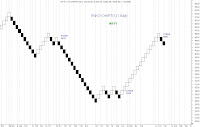 The Renko charting method is thought to have acquired its name from "renga" which is the Japanese word for bricks. Renko charts were introduced by Steve Nison (a well-known authority on the Candlestick charting method).
The Renko charting method is thought to have acquired its name from "renga" which is the Japanese word for bricks. Renko charts were introduced by Steve Nison (a well-known authority on the Candlestick charting method).To draw Renko bricks, today's close is compared with the high and low of the previous brick (white or black). When the closing price rises above the top of the previous brick by the box size or more, one or more equal height, white bricks are drawn in the next column. If the closing price falls below the bottom of the previous brick by the box size or more, one or more equal height, black bricks are drawn in the next column. If the market moves up more than the amount required to draw one brick, but less than the amount required to draw two bricks, only one brick is drawn. For example, in a two unit Renko chart, if the base price is 100 and the market moves to 103, then one white brick is drawn from the base price of 100 to 102. The rest of the move--from 102 to 103--is not shown on the Renko chart. The same rule applies anytime the price does not fall on a box size divisor.
Basic trend reversals are signaled with the emergence of a white or black brick. A new white brick indicates the beginning of a new uptrend. A new black brick indicates the beginning of a new downtrend. Since the Renko chart is a trend following technique, there will be times when the market induces whipsaws. However, a trend following technique is intended to allow traders to ride on the major portion of the trend.
Since a Renko chart isolates the underlying trends by filtering out the minor ups and downs, Renko charts are excellent for helping determine support and resistance levels.
TO SEE INTRADAY TIPS PLEASE VISIT AT
http://pangu-santhai.blogspot.com